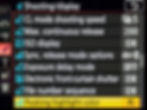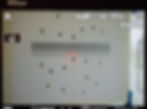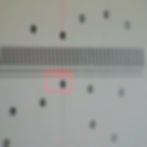Focus Peaking Accuracy Analysis for the Nikon D850
- Ed Dozier
- Apr 23, 2021
- 5 min read
I have read that manual focus using magnified Live View mode, with “focus peaking”, is the most accurate way to focus. I intend to either verify or debunk this claim.
My software of choice for analyzing image sharpness is MTFMapper. Did you know that the mars rover Perseverance main lenses (on the stereo-panorama Mastcam-Z) were measured and qualified using Frans van den Bergh’s MTFMapper? This software is more than capable of determining just how good focus peaking really is.
The lower the focus peaking level value, the narrower the depth of focus that shows peaking information. For the tests that follow, I tried setting the peaking level to 1, but it generally provided no useful feedback for many subjects. The peaking level 2 gave the best combination of useful feedback and focus discrimination. Peaking level 3 wasn’t nearly picky enough, and so wasn’t a useful test. At high LCD screen magnifications, peaking doesn’t provide any feedback at all, so I used the highest magnification that still provided peaking feedback.
As you’ll see, it turns out that focus peaking feedback really depends on the level of subject detail and which focus peaking level you select. If the subject detail is either too fine or too coarse, then there’s often no peaking feedback at all at peaking level 1!
To be able to physically measure the quality of the peaking information, I used one of the focus target designs that are available at the MTFMapper website. I would manually focus on this target using focus peaking, and then evaluate the resulting (raw-format) photograph. I chose this particular target, because it has details at 3 different levels to evaluate small, medium, and large details.
Since I use the MTFMapper program to help me calibrate my phase-detect focus, I will also compare the accuracy of my phase-detect autofocus against the manual focus-peaking results.

Focus Peaking Level Selection from “i” button
To invoke focus peaking, the D850 focus mode selector switch has to be set to “M” and then click the “i” button while in Live View to set some peaking level other than “off”. Thereafter, anytime you’re in Live View in manual-focus mode, focus peaking will be active with the level you last used. The shooting/display option d8 from the ‘pencil' menu will let you select a peaking color other than the default red.

Peaking highlight color selection d8

Peaking hightlight colors
Depending upon your subject, you can choose between red, yellow, blue, or white peaking highlight colors.

Focus Peak level #1 LCD screen
If you don’t look carefully, you won’t even see any of the red “peaking” highlights at peaking level #1 in the shot above. I am using a chart that is slanted at 45 degrees, and then used manual focus to get the little black dot inside the red square into focus.
Without using my LCD viewfinder magnifying loupe, it was very, very difficult to see the red level #1 peaking highlights.

Detail of LCD screen showing peaking level 1 highlights
For this and the other test shots, I used an 85mm lens at f/1.4 and I set my D850 to “DX” mode. The focus distance was 1.5 meters. This combination of hardware yields an extremely narrow depth of focus, to make it easier to evaluate focus peaking accuracy.
The black target dot being focused is 10mm in diameter. The horizontal band of little rectangles just above the black dot are at a spacing of 2mm. The other focus target markings, either coarser or finer, generally don’t get registered by the focus peaking at all. Since the black target dot itself didn’t get any red focus peaking highlights, I had to use the scale above the dot to manually focus.

LCD screen magnified view
I used the “+” magnifying glass button to zoom in on the LCD screen. If I magnified the view any more than what’s shown above, then there was no displayed focus peaking marker to be found. I could see the “peaking level 1” highlights only slightly better at this level of screen magnification.
Even at the maximum accuracy level of the focus peaking, the little highlights already extend to about 3 subject dot diameters, or about 21mm of actual focus depth.
I used the middle of the focus-peaking red band to determine the best manual focus. If I didn’t have the continuous band of little rectangles at just the right frequency to help me focus, then the focus peaking level #1 would have been useless for this particular subject.
I don’t think the feedback provided by focus peaking level #1 is generally useful enough to select this setting for general photography. You’ll end up questioning if focus peaking is active or not in many shooting situations.

Focus peaking level #2 with un-magnified view
Next, I switched to focus peaking level #2. Now, I’m getting better feedback to determine focus. The little 2mm-spaced rectangles above the target dot indicate that roughly 4 dot-diameters (around 25mm of focus depth) is now “in focus”.

LCD screen detail, peaking level 2
All of the target markers in the band of sharp focus now have some focus-peaking highlights on them. I’d consider this peaking level to be generally useful for most subjects. The question is, however, if all of those red focus-peaking pixels are really indicating sharp focus.

Focus peak level #3
The focus-peaking highlights at level #3 are indicating that a 55mm-wide band is in focus (a depth of 39mm). This is really getting sloppy for focus. Just imagine if the target was a single vertical structure; the “in focus” feedback is just too inaccurate. If I were to photograph a flat subject parallel to the camera sensor, then my focus would probably be really bad.

Actual resolution measurements using focus-peaking
Shown above is an extreme close-up of the target with MTF50-lp/mm resolution measurements included. I used focus peaking level #1 feedback to determine how to manually focus on the black dot. The feedback used to focus was the horizontal band of little rectangles just above the dot, since the target dot didn’t get any peaking feedback itself. I chose the middle of the area that had the red focus-peaking highlights to estimate where to place focus.
The final focus was excellent, and about as good as you could ever hope to get. This shows that focus-peaking can achieve excellent focus accuracy, but only when your subject happens to give sufficient peaking feedback. You need to be able to estimate the “middle zone” of focus, which for some subjects won’t exist.
The “acceptable” focus depth in these tests for me is actually about 15mm, while the focus-peaking feedback indicated the depth was about 21mm in the best case (peaking level #1). Again, this was using an 85mm lens at f/1.4 from 1.5 meters away. My own level of acceptable focus is based upon resolution loss, and it’s probably a little more picky than most people’s idea of what’s acceptable.

Calibrated phase-detect autofocus
So, how’s all of this manual focusing compare to simple (calibrated) phase-detect auto-focus? Not much difference, actually. The shot above was made using AF-C focus after fine-tune calibration, which for this lens and camera combination is +2 at f/1.4. It’s just about as accurate as focus peaking, and a whole lot faster and easier to use.
For people that don’t carefully calibrate focus, then using focus-peaking will almost certainly achieve better focus than using phase-detect focus. Personally, using Live View and focus peaking is a bit too painful for me, and almost impossible outdoors unless I bring along my LCD viewfinder loupe that shades the screen from sunlight. Mirrorless cameras with in-viewfinder focus peaking are the way to go, at least for manual-focus lenses.
The only time I use focus peaking is when I use my manual-focus lenses and I have a static subject (and my screen loupe to block the sunlight). At least I can be pretty confident that this method does in fact help me set optimal focus for most subjects. If I had to choose a single focus peaking level, then I’d say that level #2 is the Goldilocks setting.


















